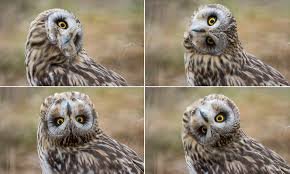Many kinds of birds have flexible necks, but owls are among some of the most outstanding when it comes to spinning their heads. While it’s a widespread fallacy that owls can tilt their heads 360 degrees, they nevertheless can execute some pretty remarkable feats when it comes to checking out their environment. Owls don’t require eyes in the rear of their heads to view what’s behind them — they can just swivel their heads all the way around. In reality, several owl species, such as the barred owl, can rotate their heads 270 degrees in either direction, which means they can look to the left by rotating all the way to the right, or vice versa.
Can birds turn around their heads?

It’s actually usual for most birds to tuck their heads back when they sleep, and if you study them closely, birds spend a lot of time cleaning their feathers, from their neck all the way down to their tail. Parrots like Zoe have 10 bones in their necks called cervical vertebrae, and they can’t move their head all the way around, but they can go almost 180 degrees. Now, raptors, which include eagles, hawks, falcons, and owls, among others, have 14 or more vertebrae in their necks. Hara Harris’s hawk can spin her head a complete 180 degrees, which allows her to groom her feathers, but neck flexibility is also one of the crucial characteristics that allow her to locate prey during flight.
The eye placement on the front of her head affords her binocular vision, meaning the field of vision for each eye overlaps, and this allows for more precise depth perception, which makes her an exceptional hunter. But even hawks can’t spin their head entirely around, and in fact, there isn’t a single bird that can, but there is one that gets quite close.
Can an owl spin its head all the way around?

The response can be yes or no, depending on the starting place of the head. Equally as astounding as the head-turning habits of owls are how they can rotate their necks as much as they do without cutting off blood flow to their brains. Research conducted in 2013 at John Hopkins University School of Medicine aimed to explain just that. Attempting to turn one’s head as quickly or as far as an owl does would result in the tear of artery linings, which could lead to blood clots and stroke, according to research author Dr. Philippe Gailloud.
The bone and vascular structure of the heads and necks of a dozen naturally deceased owls might be studied using medical imaging. Blood arteries that can adapt to an owl’s movement were discovered by scientists. When owls rotate their heads, their blood vessels widen, allowing the imaging dye that mimics blood to flow and eventually pool into tiny reservoirs. Human arteries, on the other hand, tend to contract during head rotations. Researchers believe that the presence of these reservoirs helps to keep blood flowing to the eyes and brain even when the owls’ heads are rotating.
How is it possible for an owl’s head to turn 360 degrees?

Additionally, the bones in owls’ necks have been modified to allow for greater degrees of rotation. The transverse foramina holes, through which one of the primary arteries supplying the birds’ brains flows, were found to be 10 times greater in diameter than the artery itself. Twelve of the owls’ neck vertebrae possessed this modification, which provides air spaces that allow the artery to move around when bent.
Also, know How does owls sleep?
“The vertebral artery follows the contours of the neck’s hollows in humans. On the contrary, owls’ anatomical adaptations allow for better vascular mobility and suppleness “de Kok-Mercado was quoted as saying. Besides that, the vertebral artery in the neck of owls enters the neck at the 12th cervical vertebrae, rather than the 14th cervical vertebrae, which provides more slack for the neck muscles.
How do owls turn their heads around?

To understand why an owl needs a flexible neck, we can compare their eyes to our own. You can see more if you keep your head motionless and shift your eyes to the left, right, up, and down in order to see as much of the surrounding area as possible. As a result, we have six muscles in each eye that allow us to move our eyes in a variety of directions. As a result, we can see everything without having to move our heads.
The eyes of owls, on the other hand, are highly distinct. The eyes of an owl are formed like tubes and are held in place by sclerotic rings, a type of bony structure. If they wish to glance about, they’ll have to turn their entire head, as their eyes don’t move much. Owls can, of course, tilt their heads, but not quite as far as humans can. Humans can tilt their heads around 90 degrees to the right or left from a front-facing position.
Owls, on the other hand, have the ability to tilt their heads 270 degrees to the left or right! An incredible sight to see. This is because most people have heard of the fact that owls can turn their heads a lot, even though this isn’t true.

Let’s begin by contrasting our own necks with those of an owl. For humans, there are seven cervical vertebrae, whereas for birds, there are 14, and in some circumstances, a joint’s range of motion and flexibility can be increased by having more bones at that joint.
An owl’s whole range of motion if it starts with its head at the maximum twist of 270 degrees from the front, then returns to the front and rotates in the other way is 540 degrees. When it comes to side-to-side rotation, a person can only go so far.





